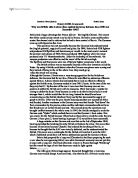Furthermore, another vital factor to consider is Hitler’s mistakes during the war. In the early part of the Second World War, Germany looked unstoppable – but as Hitler’s self-confidence grew, his ability to guide the war effectively proved to inadequate. First, launching a war against Russia whilst fighting Britain was over ambitious. Certainly, Operation Barbarossa was launched later than German strategists had anticipated and for this reason the Germany army was unable to reach Moscow before the first snows of winter. Therefore, they found themselves unprepared for the harsh conditions. Secondly, Hitler decided to lay siege on Leningrad and Moscow – rather than taking them by force. This prolonged war and gave the Russian armed forced time to regroup and mount a successful counter-offence. Finally, Hitler sent troops to Stalingrad and Ukraine before conquering Leningrad or Moscow. This move overstretched the German Army and meant that Hitler was unable to conquer Russia’s capital. Therefore, the weaknesses of the Germans helped Russia to win in 1945.
The last but most essential factor to consider is the mobilisation of the Russian nation. Stalin was under no illusions that communism was being to be unpopular in Russia, due to the Great Terror and the failures of Stalin’s economic policy and he also knew that traditional communist propaganda would not mobilise the Russian people. Therefore, he tried appealed to Russian patriotism. The war itself was named ‘THE GREAT PATRIOTIC WAR’ and Russian people were encouraged to use nationalist nicknames such as ‘Fritz’ to refer to the Germans. Patriotism helped Stalin to win the war, because it provided the Russians with a reason to fight. Joseph Stalin shrewdly altered the presentation of communist ideology during the war by making an alliance with the Church. Despite that, religion was still controlled by Stalin and the party – the leader of the Russian Orthodox Church proclaimed that Stalin was ‘God’s chosen leader’ and that the fight against Germany was a Holy War. This caused Stalin to officially close the communist publication ‘THE GODLESS’ in 1941 and allowed 414 churches to reopen by the final year of the war. By reopening of the churches, Stalin believed that the teachings of the Church would inspire soldiers and their families back home to continue to fight for victory. Patriotism also inspired many to fight due to love of their country. Appealing to the nation and the church was more effective at motivating people than appeals to communism.
Furthermore, women were also responsible for the Home front during the war. In addition to looking after the home and having to deal with rationing, women had to work in industry and agriculture. This involved 12-18 hours per day at the factory and then during harvest time, working night shifts on farms to bring in the crops. Certainly, days off were cancelled and the first holiday in 4 years occluded on 9th May 1945! Women played an important role in helping mobilise the Home Front.
Furthermore, another way of mobilising the Home front – was done by the NKVD, who drew up lists of non-Russian people living in the USSR who might be sympathetic to Germany. The NKVD then either relocated these people or murdered them to prevent them aiding the Germans. For example, the Kalmyks – an ethnic group of 130,000 were deported to Siberia following the German invasion. By 1953, following the years of brutal treatment around 60% of those deported had died. One can conclude that, Stalin’s propaganda emphasised the importance of the defence of the ‘Motherland’ by the USSR’s ‘brothers and sisters.’ Therefore, a new national anthem was introduced in 1944, which glorified the USSR. This was essential and necessary to motivate the Russian people to defeat the Germans in 1945.
In conclusion, one can argue that the allied support, was an important aspect of Russian victory but it was not the main reason. Clearly, the Lead-lease programme provided essential support in terms of food and transport. In addition, the opening of new fronts in North Africa and Western Europe – forced the Germans to overstretch their troops. Another key main reason for Russia’s victory in the Second World War was Hitler’s strategic mistakes. Hitler could have taken Moscow by storm and in so doing knocked Russia out of the war. However, he chose to besiege the city and therefore gave General Zhukov time to organise a counter-attack and Gosplan time to develop a war economy. But, the most important and crucial factor to explain why the USSR was able to defeat Germany in 1945 was the mobilisation of the Home Front. Stalin knew that the teachings of the Church would inspire soldiers and their families back home to continue the fight for victory as the promise of heaven would be a comfort in the face of suffering and death. In this way, the Home Front was crucial to Russia’s victory in the Second World War because of the careful use of propaganda and the appeal of the Church motivated the Russian people to fight with all their heart and soul for victory. This resulted in 10% of the Russian population to die for the Motherland. Without the will and determination of the Russia people they would not have been able to save their country from defeat and ensured her victory.







